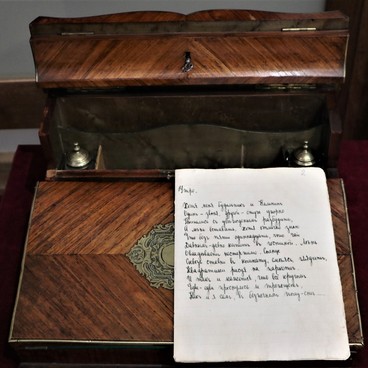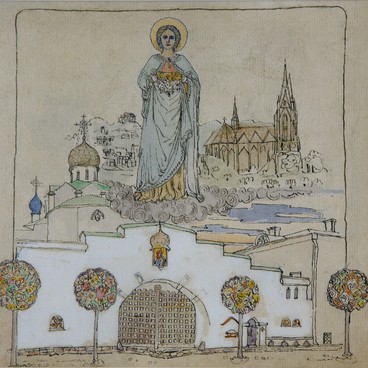The Napolnaya School of the town of Alapayevsk was a zemstvo school, which served as prison for the Grand Dukes Romanovs in 1918. It was guarded by Red Army soldiers. The recreated image demonstrates the soldiers’ costume in the warm season: a battle-grey tunic with a belt, a sheepskin hat with a red ribbon (it could be replaced with a peaked cap), a shirt with a standing collar and wide woolen trousers that were tucked into riding boots or boots with wrappers.
Generalized character of a guard
Dimensions
195x45x30 cm
195x45x30 cm
195x45x30 cm
Technique
Реконструкция
1
Open in app#12
Generalized character of a guard
#4
#3
In winter, the army men wore a short fur coat or a soldier’s overcoat that was a comfortable coat with folds on the back and a half-belt. A pouch of leather or tarpaulin was worn on a belt, and ammunition was stored in it. For carrying cartridges, a fabric cartridge belt with individual cells was also used. They put it on as a belt or across the chest, to get ammunition quickly and conveniently.
As a rule, the equipment was Russian-made, but sometimes during the Civil War soldiers also used foreign articles, French, American, English, and even German.
#7
The guards of the Napolnaya School, site of imprisonment of the Romanovs and their close associates, were armed with revolvers of the Nagant system. The weapons were specially made for the Russian Empire by Belgian industrialists, the Nagant brothers. Later, the manufacture of revolvers started at the Tula arms factory. The soldiers were also armed with grenades and Mosin rifles.
#9
The Red Guard was formed immediately after the revolution from volunteer detachments of workers and peasants. At first, the soldiers did not have special uniforms; they dressed like soldiers of the former imperial army.
The belt buckle with the royal eagle, symbol of autocracy, was turned upside down. On the sleeve, the Army men wore a band with the inscription ‘Red Guard’ on the sleeve, and sometimes tied red ribbons to their headgear.
#10
In 1918, the Red Army was formed. At first, its soldiers were even allowed to wear civilian clothes, but they had to show that they belonged to the army: soldiers pinned or sewed a red bow or a scarlet ribbon on their chests.
#11
Over time, uniforms were developed for them. Famous artists, including Viktor Vasnetsov, Boris Kustodiev and many others worked on this project.
#13
Sverdlovsk Regional Ethnography Museum
read morehide
00:00
00:00
1x
Generalized character of a guard
Dimensions
195x45x30 cm
195x45x30 cm
195x45x30 cm
Technique
Реконструкция
1
Open in app
Share



